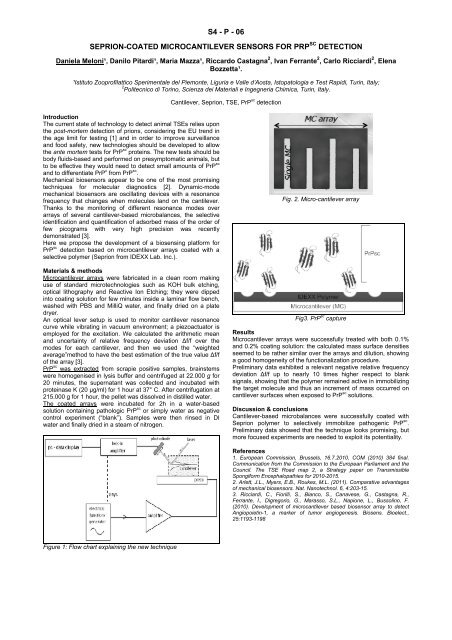Abstract Book of EAVLD2012 - eavld congress 2012
Abstract Book of EAVLD2012 - eavld congress 2012
Abstract Book of EAVLD2012 - eavld congress 2012
You also want an ePaper? Increase the reach of your titles
YUMPU automatically turns print PDFs into web optimized ePapers that Google loves.
S4 - P - 06<br />
SEPRION-COATED MICROCANTILEVER SENSORS FOR PRP SC DETECTION<br />
Daniela Meloni¹, Danilo Pitardi¹, Maria Mazza¹, Riccardo Castagna 2 , Ivan Ferrante 2 , Carlo Ricciardi 2 , Elena<br />
Bozzetta¹.<br />
¹Istituto Zoopr<strong>of</strong>ilattico Sperimentale del Piemonte, Liguria e Valle d’Aosta, Istopatologia e Test Rapidi, Turin, Italy;<br />
2<br />
Politecnico di Torino, Scienza dei Materiali e Ingegneria Chimica, Turin, Italy.<br />
Cantilever, Seprion, TSE, PrP sc detection<br />
Introduction<br />
The current state <strong>of</strong> technology to detect animal TSEs relies upon<br />
the post-mortem detection <strong>of</strong> prions, considering the EU trend in<br />
the age limit for testing [1] and in order to improve surveillance<br />
and food safety, new technologies should be developed to allow<br />
the ante mortem tests for PrP sc proteins. The new tests should be<br />
body fluids-based and performed on presymptomatic animals, but<br />
to be effective they would need to detect small amounts <strong>of</strong> PrP sc<br />
and to differentiate PrP c from PrP sc .<br />
Mechanical biosensors appear to be one <strong>of</strong> the most promising<br />
techniques for molecular diagnostics [2]. Dynamic-mode<br />
mechanical biosensors are oscillating devices with a resonance<br />
frequency that changes when molecules land on the cantilever.<br />
Thanks to the monitoring <strong>of</strong> different resonance modes over<br />
arrays <strong>of</strong> several cantilever-based microbalances, the selective<br />
identification and quantification <strong>of</strong> adsorbed mass <strong>of</strong> the order <strong>of</strong><br />
few picograms with very high precision was recently<br />
demonstrated [3].<br />
Here we propose the development <strong>of</strong> a biosensing platform for<br />
PrP sc<br />
detection based on microcantilever arrays coated with a<br />
selective polymer (Seprion from IDEXX Lab. Inc.).<br />
Materials & methods<br />
Microcantilever arrays were fabricated in a clean room making<br />
use <strong>of</strong> standard microtechnologies such as KOH bulk etching,<br />
optical lithography and Reactive Ion Etching; they were dipped<br />
into coating solution for few minutes inside a laminar flow bench,<br />
washed with PBS and MilliQ water, and finally dried on a plate<br />
dryer.<br />
An optical lever setup is used to monitor cantilever resonance<br />
curve while vibrating in vacuum environment; a piezoactuator is<br />
employed for the excitation. We calculated the arithmetic mean<br />
and uncertainty <strong>of</strong> relative frequency deviation Δf/f over the<br />
modes for each cantilever, and then we used the “weighted<br />
average”method to have the best estimation <strong>of</strong> the true value Δf/f<br />
<strong>of</strong> the array [3].<br />
PrP sc<br />
was extracted from scrapie positive samples, brainstems<br />
were homogenised in lysis buffer and centrifuged at 22.000 g for<br />
20 minutes, the supernatant was collected and incubated with<br />
proteinase K (20 μg/ml) for 1 hour at 37° C. After centrifugation at<br />
215.000 g for 1 hour, the pellet was dissolved in distilled water.<br />
The coated arrays were incubated for 2h in a water-based<br />
solution containing pathologic PrP sc or simply water as negative<br />
control experiment (“blank”). Samples were then rinsed in DI<br />
water and finally dried in a steam <strong>of</strong> nitrogen.<br />
Fig. 2. Micro-cantilever array<br />
Fig3. PrP sc capture<br />
Results<br />
Microcantilever arrays were successfully treated with both 0.1%<br />
and 0.2% coating solution: the calculated mass surface densities<br />
seemed to be rather similar over the arrays and dilution, showing<br />
a good homogeneity <strong>of</strong> the functionalization procedure.<br />
Preliminary data exhibited a relevant negative relative frequency<br />
deviation Δf/f up to nearly 10 times higher respect to blank<br />
signals, showing that the polymer remained active in immobilizing<br />
the target molecule and thus an increment <strong>of</strong> mass occurred on<br />
cantilever surfaces when exposed to PrP sc solutions.<br />
Discussion & conclusions<br />
Cantilever-based microbalances were successfully coated with<br />
Seprion polymer to selectively immobilize pathogenic PrP sc .<br />
Preliminary data showed that the technique looks promising, but<br />
more focused experiments are needed to exploit its potentiality.<br />
References<br />
1. European Commission, Brussels, 16.7.2010, COM (2010) 384 final.<br />
Communication from the Commission to the European Parliament and the<br />
Council. The TSE Road map 2, a Strategy paper on Transmissible<br />
Spongiform Encephalopathies for 2010-2015.<br />
2. Arlett, J.L., Myers, E.B., Roukes, M.L. (2011). Comparative advantages<br />
<strong>of</strong> mechanical biosensors. Nat. Nanotechnol. 6, 4:203-15.<br />
3. Ricciardi, C., Fiorilli, S., Bianco, S., Canavese, G., Castagna, R.,<br />
Ferrante, I., Digregorio, G., Marasso, S.L., Napione, L., Bussolino, F.<br />
(2010). Development <strong>of</strong> microcantilever based biosensor array to detect<br />
Angiopoietin-1, a marker <strong>of</strong> tumor angiogenesis. Biosens. Bioelect.,<br />
25:1193-1198<br />
Figure 1: Flow chart explaining the new technique


